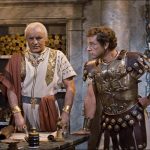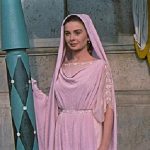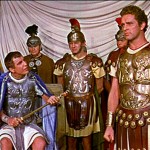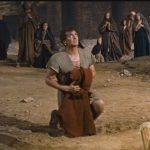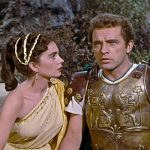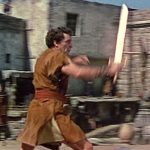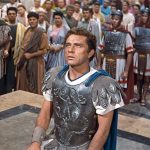
The Robe – 1953
Here we are with another Biblical Epic, on par with other great films like Quo Vadis, Ben-Hur, and The Ten Commandments. It was well made and had a competent cast of actors. This one had a rather unique perspective and was the story about the Roman soldier who won the Robe of Christ after the crucifixion
He was Marcellus Gallio, played by Richard Burton. He was a very young and very attractive lead who was not portrayed as a saint until the end of the film, though I suppose that is part of the point. He started out with very human, or should I say “Roman” flaws. But he also has that classic transformation in which he changes from a dim-witted heathen to a Christian. Burton did a fine job. He was not overly dramatic, nor was his performance lacking in energy or skill.
Opposite him was the character of Diana, played by the beautiful Jean Simmons. The two had been lovers since before the time of the plot and, of course, they ended up together in the end. Still, the writer did a fine job of doing it in a slightly unexpected way… slightly. Simmons seemed to have a good on-screen chemistry with Burton, and they looked natural together.
But it was the next most prominent role that I didn’t particularly care for. Demetrius, played by Victor Mature, Marcellus’s Greek slave, just didn’t sit right with me. First of all, Mature’s acting didn’t seem up to par with his co-stars. It was almost as if he had been used to acting for the stage, and didn’t seem to know how to act in front of a movie camera. I am well aware that this was not the case. This film came right in the middle of his busy career as an actor. But for my tastes, he just seemed slightly hammy and overdone.
Jay Robinson also did a good enough job as the Roman Emperor, Caligula. He had that edge of childish insanity and pulled it off fairly believably though, to be honest, there were moments where he seemed to be a bit over-the-top. But I’ll be the first to admit that maybe I am being a little too harsh. Maybe the wild and grandiose portrayal was more accurate than I am giving it credit for.
The Robe was interesting in that it took a nearly negligible character from the Bible and made up a complete story around the small part he played in the crucifixion. Not only did Marcellus win the garment, they also made him the soldier that did the actual crucifying. He gives the robe to his slave, Demetrius, who is already a follower of the teachings of Christ. Demetrius takes the robe and runs away.
Marcellus becomes haunted by the experience and loses his mind. In order to regain his sanity, he is sent on a mission to find the robe, thinking that it was the bewitched cloth that cursed him with madness. He finds it, and Demetrius, in the company of the Christians. He learns of their gentle, peace-loving ways and gradually begins to see the evil inherent in the leaders of Rome. His conversion to Christianity ends up getting him, and subsequently, his girlfriend Diana, put to death, and who doesn’t appreciate the noble deaths of martyrs.
I’m not sure if I would call the plot inspirational or stirring, but it was certainly interesting and cleverly written. It was complete fiction, but it had just the right mixture of religious mysticism and reality to draw me in to the story. Grand or not, it was a well-made film. The sets and costumes were good and the sweeping cinematography really stood out. The film’s score, written by Hollywood veteran Alfred Newman, was always appropriate and did a fine job of enhancing the action taking place on the screen.
And just as an interesting note, this was a pretty special film in cinema history. It has the distinction of being the first movie released in the widescreen process CinemaScope. However, it should also be noted that because very few movie theaters were equipped to show widescreen films, many scenes were filmed a second time. Actors and sets had to be crowded closer together to accommodate the smaller screens in most movie houses. In fact, some of the dialogue between the two versions was even different.
